How to Contain Bamboo - A Helpful Illustrated Guide
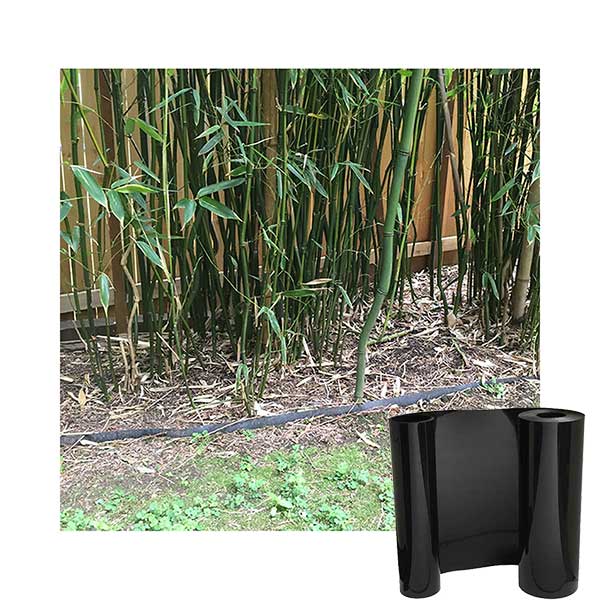
Welcome to our bamboo guide. We put together this guide to help give our customers a better understanding how to contain bamboo by understanding a little about the plant, the different types and which may be ideal for their application. The main concern that we hear from people planting bamboo is regarding how to control the bamboo roots (rhizomes) and prevent them from overtaking the landscape. We address this issue specifically in the following guide.
Section 1: About Bamboo
Section 2: Bamboo Barrier Installation Guide
Bamboo is an evergreen perennial plant which popular because it grows fast and has a nice visual aesthetic. There are two primary types of bamboo; those with clumping “rhizomes” (roots) and those that spread out referred to as running rhizomes.
The article below deals with how to properly control invasive running bamboo
varieties known for becoming invasive if not confined. We'll go step by
step on properly containing bamboo through the use of high-density Polyethylene bamboo
barriers.
Although bamboo has a reputation for getting out of control (and rightfully so!) with the proper barrier it can be effectively contained and can contribute to a beautiful landscape.

The easiest way to contain bamboo is by confining the space where the bamboo rhizomes (roots) can spread. By restricting the rhizomes and cutting down undesirable new shoots, you can allow them to thrive without worry of escape.
Many varieties of bamboo are sought after because they serve as excellent privacy screens and are evergreen year-round. Bamboo has become very popular over the last few decades as it's attractive, low maintenance, and straightforward to plant.
Some fast-growing species (not common in the United States) of bamboo can grow up to 2 inches per hour in the right climates making it one of the fasting growing plants globally.
Some species reach full maturity in just three months and most mature in only a few years.
Running vs. Clumping Bamboo
Running bamboo can produce root shoots up to 40 feet in just a single season. The running rhizomes are invasive and can easily spread throughout the landscape if not property contained.
Clumping bamboo do not need as much control as they are typically self-containing. In more rare circumstances clumping bamboo can spread and when this does happen it can push with a high amount of force. For this reason, if planting clumping bamboo near a important structure or very sensitive area of the landscape, a barrier of 100 mil thickness is strongly recommended. Due to it's self-containing nature, the threat for invasion is much lower than their running rhizome cousin.
Not all types of bamboos can grow out of hand. The clumping rhizome species have short rhizomatous structure, which makes it difficult for them to stretch more than several inches, eventually making discrete clumps. These clumps will grow as new one’s form and may need anywhere between 2 to 10 feet or more space for them to reach full maturity.
Running rhizomes grow underground undetected up to 20 feet away from the original planting. If they encounter a surface that they cannot grow through, or around, then they will change course and try a different direction. Because of this predictable behavior it's crucial to properly place and install a bamboo barrier so that there are no breaches in the barrier wall, and the rhizomes are unable to escape. If left alone, rhizomes will travel under driveways, sidewalks, patios, house foundations, and even sometimes through the cracks in the concrete floors such as sheds and garages
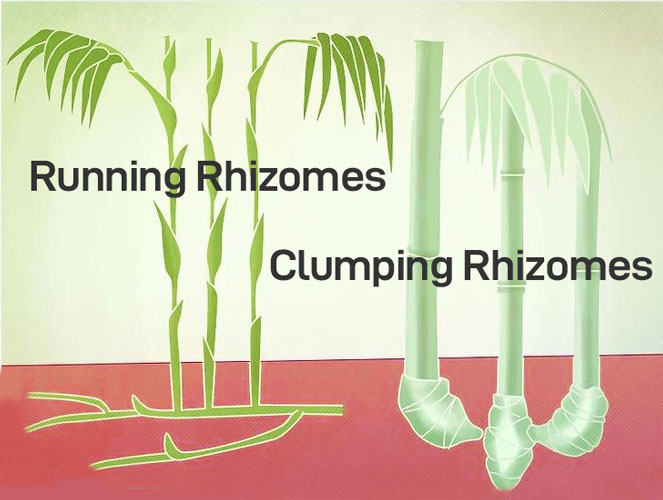

How do I keep bamboo from spreading?
The most effective way to keep bamboo plants from spreading is to install a subsurface barrier. To be useful for long term containment, the boundary should be made of HDPE (High-density polyethylene) and should be installed around the planting area.
To ensure that the bamboo rhizomes (the part of the bamboo plant that spreads) stay contained, it's recommended that the planting area is completely encircled. Additionally, the bamboo barrier should protrude approximately 2" above the ground. This protrusion allows the gardener to monitor the top edge of the plastic to quickly catch and manually prune any rhizomes that attempt to "jump" the barrier.
What is Bamboo Barrier?
A bamboo barrier is any product used in bamboo planting to prevent the spread of root rhizomes to protect valuable hardscapes and surrounding properties from damage. Plastic Bamboo barrier is most common and is available in different lengths and thickness depending on your application.
The barrier is usually a diversion type control technique with a smooth surface on the side facing the bamboo planting. A bamboo barrier is made from HDPE, a high-density polyethylene, which is more robust and superior to metals since it will not rust and is easy to install and will not rust or corrode over time.
Rhizome barriers are available in 18", 24", 30", 36", and 48" deep to offer additional protection from stray growth. The polyethylene material used to make bamboo barriers is from recycled regrind. The wall is impermeable to water and can also act as a water barrier.
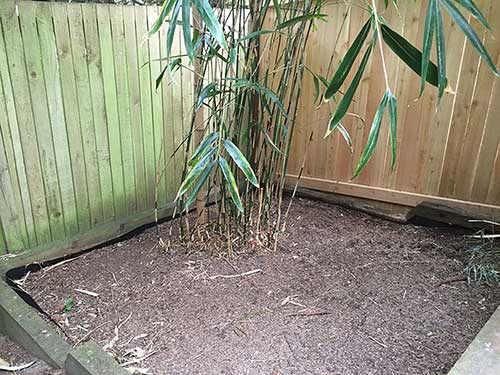
How do Bamboo Barriers Work?
Bamboo barriers offer an effective method of controlling the spread of bamboo rhizomes.To understand how bamboo barriers work, you first need to know how running bamboo spreads. Running bamboo spreads by sending out rhizomes or stems underground. The stems can reach 20 from the original plant. Once stretched out, new stems spread again from this point.
To contain the rhizomes the smooth High-Density plastic barrier acts as blockade to the running shoots and prevent them from leaving the planting area. The shoots after hitting the barrier with change direction and try to spread in a different direction. Most bamboos don’t tend to grow below 20” deep although it is possible depending on the specific variety.
What thickness of barrier do I need?
The actual thickness of the barrier required can vary depending on several different environmental factors, as well as the species of bamboo planted. Although 30 mil and 40 mil barriers can be useful in containing bamboo, there have been reports in various online bamboo communities of rhizomes "punching through" 30 and 40 mil material.
A 60-mil thickness is suggested for most bamboo plantings and 80-mil for more aggressive or larger species such as timber bamboo. 100-mil barriers are typically reserved for the most invasive bamboo, or for areas of critical concern where bamboo overgrowth would damage a costly property or landscaping.
PRO TIP: Best practice is to use 60 mil or thicker barrier for bamboo installations and rhizome defense.
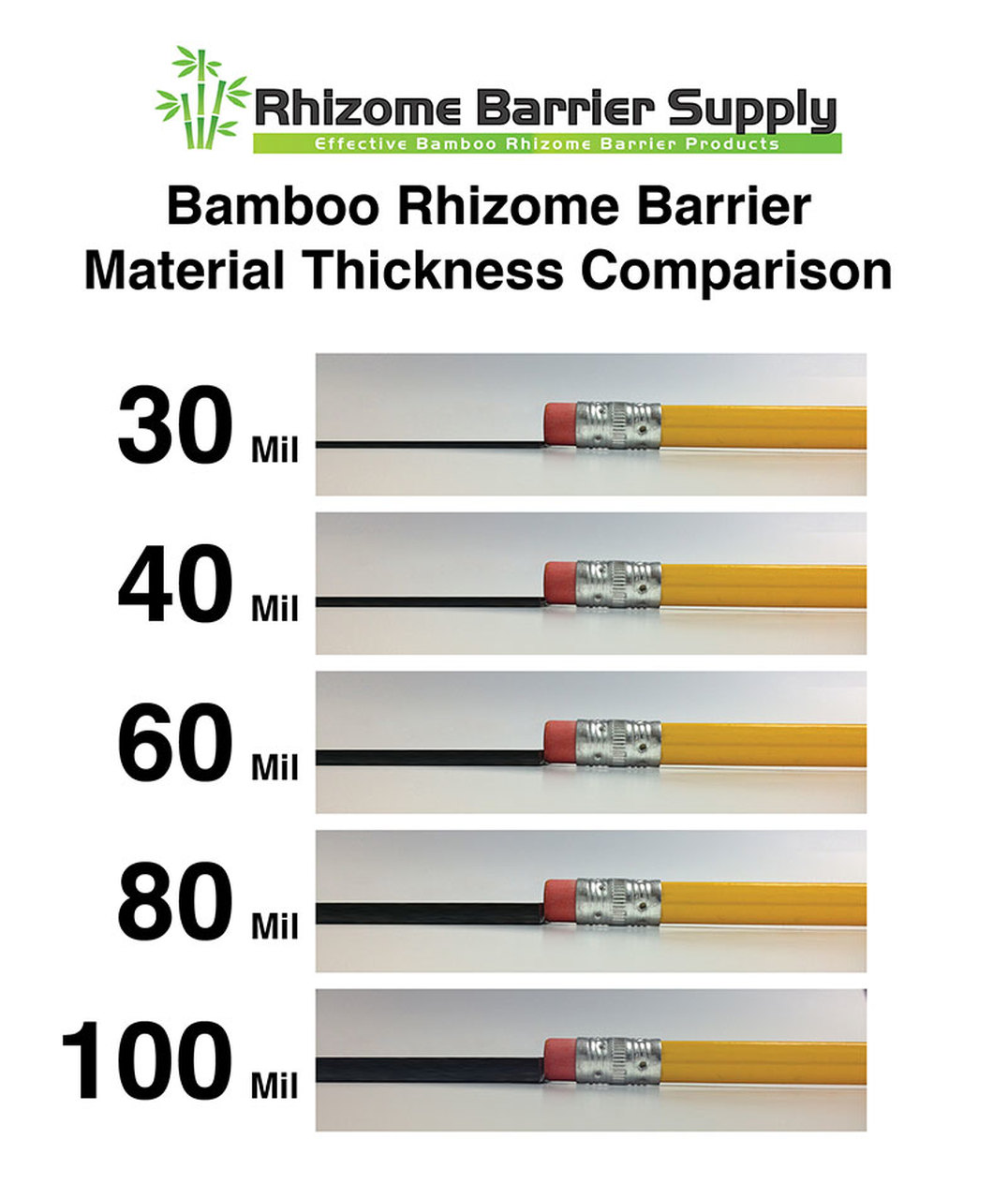
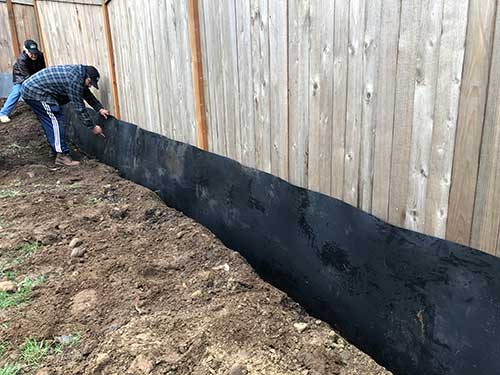
How Deep Does Bamboo Barrier Need to Be?
Typically bamboo roots or rhizomes tend to not grow below 20 inches deep. Because of this, many find that a 24-inch barrier to be sufficient. A typical installation for a 24-inch rhizome barrier allows for it to rest in a 22-inch depth trench and rise above grade by 2 inches.
Depending on the variety of bamboo that is planted a deeper barrier may be necessary. Site specific factors can require a deeper barrier as well such as a sloping grade or bamboo planted in a raised planter. We offer barriers in a maximum depth of 48".
Why do Bamboo Barriers Occasionally fail?
Rhizome Barriers fail primarily for the following three reasons:
1. Rhizomes make their way under a barrier that is too short, placed too shallow, or conversely, the root rhizomes make their way over the barrier wall.
2. Roots creep through cracks where the barrier ends meet due to an insufficent overlap or if an incorrect seam tape was utilized.
3. Installation of too thin plastic enables accidental holes or puncturing to occur during installation. Light barriers can fatigue over time from friction against the rocky soil.
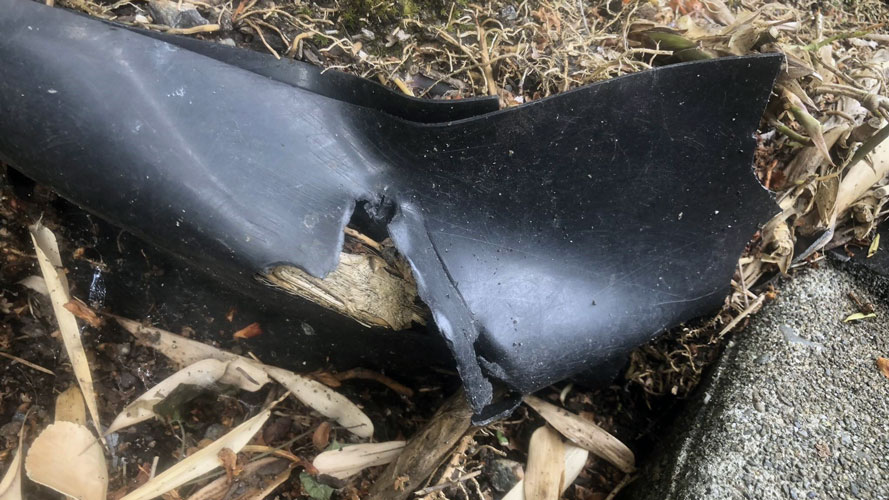
Bamboo Barrier Installation Guide
Below are steps that are involved when installing bamboo barrier around a bamboo plant.
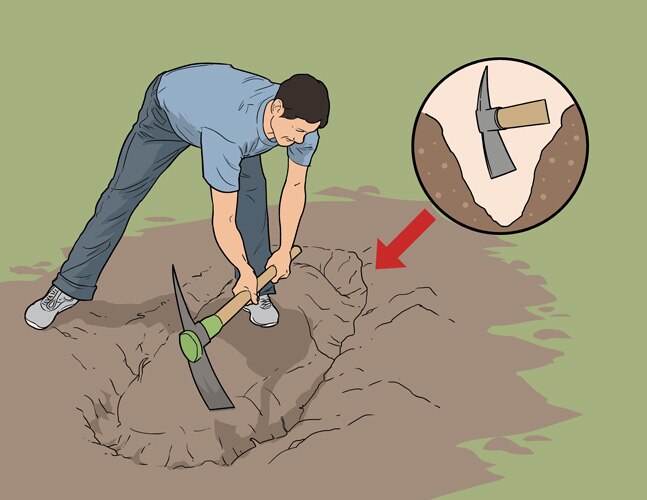
Step 1:
Dig a trench on the site where you want to plant your bamboo. Remove the topsoil and the heavier sub-soil. When preparing the site, you should be careful not to create tight corners as this may result in the barrier collapsing due to unnecessary stress to the material.
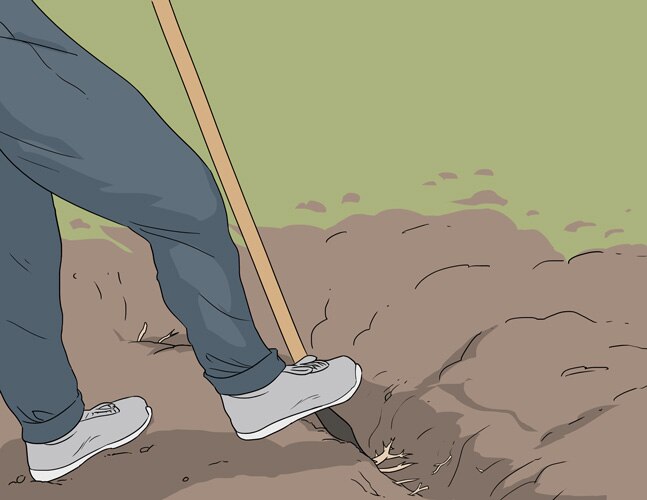
Step 2:
Remove or cut any rhizomes outside the area you need to contain. If you have well-established bamboo, it may be harder to eradicate, so the best thing to do is remove the rhizomes first.
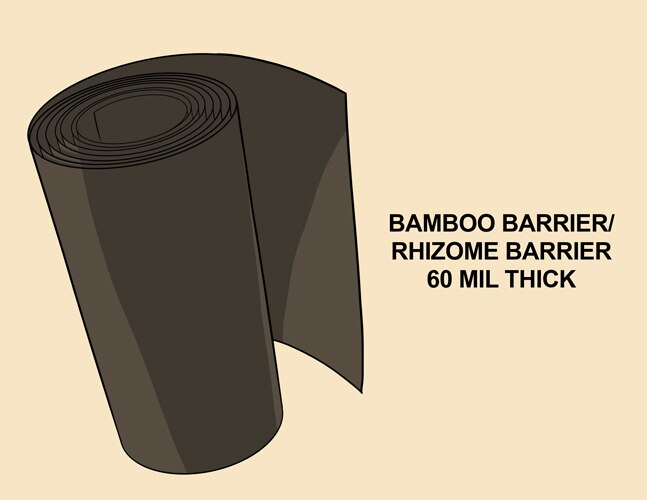
Step 3:
Choose the correct bamboo barrier for your application. In general, a 60-mil wall will work for many applications, however you can never go too thick.
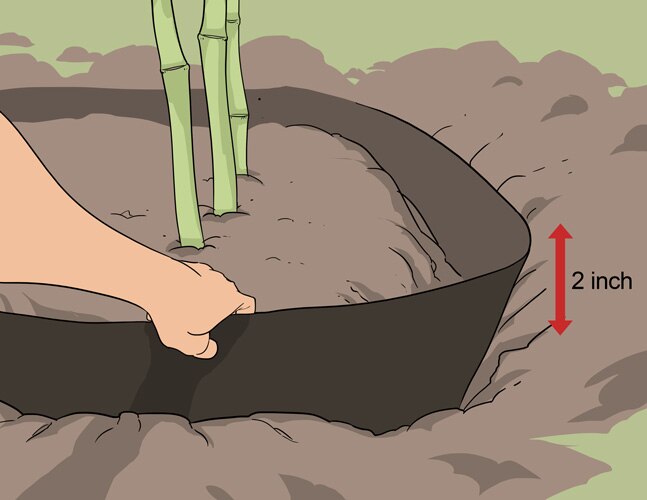
Step 4:
Place the bamboo barrier in the trench. The wall should stand out of the soil by at least two
inches. Plastic protruding above grade is essential for preventing the rhizomes
from escaping over the top without you knowing.
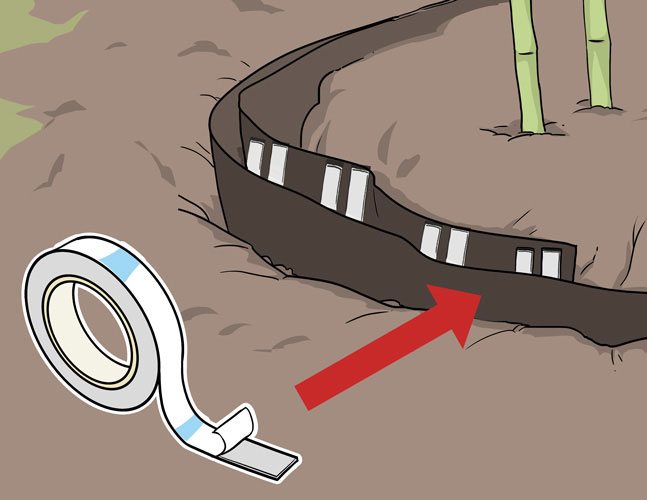
Step 5:
Overlap the barrier by 4' and use double-sided seam tape within the overlap to ensure rhizomes cannot breach the joined pieces sections. Place a number of horizontal and vertical strips within the overlap.
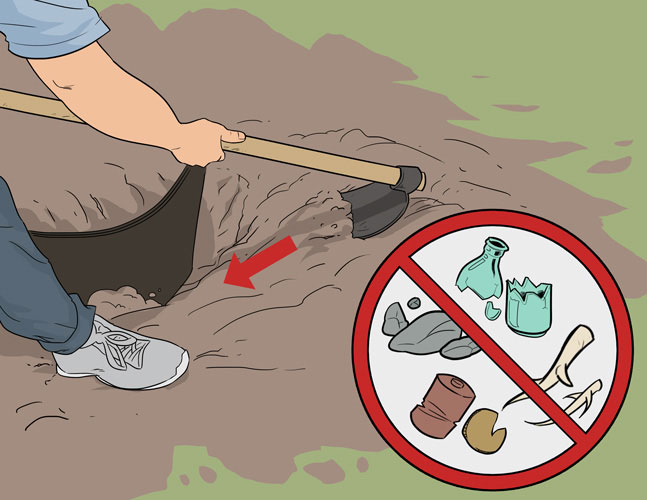
Step 6:
Backfill the trench with subsoil first and compact it to drive out any air pockets. Then complete the backfilling with the top light soil and pack it tight. Make sure there are no sharp objects when filling up the trench, including glass, stones, metal, or tree roots.
